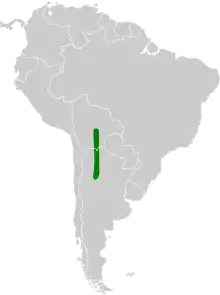Rothschild's swift
Rothschild's swift (Cypseloides rothschildi) is a Near Threatened species of bird in subfamily Cypseloidinae of the swift family Apodidae.[2][3][1] It is found in Argentina and Bolivia.[4]
| Rothschild's swift | |
|---|---|
| Scientific classification | |
| Domain: | Eukaryota |
| Kingdom: | Animalia |
| Phylum: | Chordata |
| Clade: | Dinosauria |
| Class: | Aves |
| Clade: | Strisores |
| Order: | Apodiformes |
| Family: | Apodidae |
| Genus: | Cypseloides |
| Species: | C. rothschildi |
| Binomial name | |
| Cypseloides rothschildi Zimmer, 1945 | |
 | |
Taxonomy and systematics
Rothschild's swift, white-chested swift, (Cypseloides lemosi), American black swift (C. niger), and sooty swift (C. fumigatus) form a superspecies. Some authors have treated Rothschild's and sooty swifts as conspecific.[5] Rothschild's swift is monotypic.[2]
Description
Rothschild's swift is about 15 cm (5.9 in) long. It has long, broad wings and a short squarish tail. Its plumage is a uniform medium brown.[6]
Distribution and habitat
Rothschild's swift is found from Bolivia's Santa Cruz Department south into northwestern Argentina as far as Córdoba Province. There are no records in Peru despite its being included there in some taxonomic lists. The species' habitat requirements are not well known. Most records have been over evergreen montane forest at elevations between 500 and 2,000 m (1,600 and 6,600 ft).[6]
Behavior
Migration
Rothschild's swift appears to be a year-round resident in most of its range, though it might winter at the northern end of it.[6]
Feeding
Like all swifts, Rothschild's is an aerial insectivore, but no details of its diet are known.[6]
Vocalization
As of late 2022, xeno-canto had a single recording of a Rothschild's swift vocalization, and the Cornell Lab of Ornithology's Macaulay Library had none. It reportedly makes a "short 'pip' or 'peep'" in flight.[6]
Status
The IUCN has assessed Rothschild's swift as Near Threatened. It has a small range and an estimated population of 6000 to 15,000 mature individuals; the latter is believed to be stable. Much of the Yungas forest where it lives has been logged or converted to agriculture.[1] It does occur in some protected areas.[6]
References
- BirdLife International (2016). "Rothschild's Swift Cypseloides rothschildi". IUCN Red List of Threatened Species. 2016: e.T22686450A93112177. doi:10.2305/IUCN.UK.2016-3.RLTS.T22686450A93112177.en. Retrieved 1 October 2022.
- Gill, F.; Donsker, D.; Rasmussen, P., eds. (August 2022). "Owlet-nightjars, treeswifts, swifts". IOC World Bird List. v 12.2. Retrieved August 9, 2022.
- HBW and BirdLife International (2021) Handbook of the Birds of the World and BirdLife International digital checklist of the birds of the world. Version 6. Available at: http://datazone.birdlife.org/userfiles/file/Species/Taxonomy/HBW-BirdLife_Checklist_v6_Dec21.zip retrieved August 7, 2022
- Remsen, J. V., Jr., J. I. Areta, E. Bonaccorso, S. Claramunt, A. Jaramillo, D. F. Lane, J. F. Pacheco, M. B. Robbins, F. G. Stiles, and K. J. Zimmer. Version 24 July 2022. Species Lists of Birds for South American Countries and Territories. https://www.museum.lsu.edu/~Remsen/SACCCountryLists.htm retrieved July 24, 2022
- Remsen, J. V., Jr., J. I. Areta, E. Bonaccorso, S. Claramunt, A. Jaramillo, D. F. Lane, J. F. Pacheco, M. B. Robbins, F. G. Stiles, and K. J. Zimmer. Version 24 July 2022. A classification of the bird species of South America. American Ornithological Society. https://www.museum.lsu.edu/~Remsen/SACCBaseline.htm retrieved July 24, 2022
- Chantler, P., P. F. D. Boesman, and C. J. Sharpe (2020). Rothschild's Swift (Cypseloides rothschildi), version 1.0. In Birds of the World (J. del Hoyo, A. Elliott, J. Sargatal, D. A. Christie, and E. de Juana, Editors). Cornell Lab of Ornithology, Ithaca, NY, USA. https://doi.org/10.2173/bow.rotswi1.01 retrieved October 1, 2022
